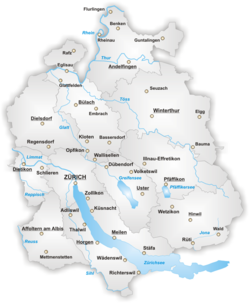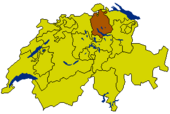Canton of Zürich
| Zürich | |||
|
|||
| Capital | Zürich | ||
| Population (2007) | 1,307,567 (Ranked 1st) | ||
| - Density | 742 /km² | ||
| Area | 1729 km² (Ranked 7th) | ||
| Highest point | 1292 m - Schnebelhorn | ||
| Lowest point | 332 m - Rhine at the border in Weiach | ||
| Joined | 1351 | ||
| Abbreviation | ZH | ||
| Languages | German | ||
| Executive | Regierungsrat (7) | ||
| Legislative | Kantonsrat (180) | ||
| Municipalities | 171 municipalities | ||
| Districts | 12 Bezirke | ||
| Website | www.ZH.ch | ||
 |
|||
The Canton of Zürich (German: Kanton Zürich) has a population (in 2007) of about 1.3 million[1]. The canton is located in the northeast of Switzerland and the city of Zürich is its capital. The official language is German, but people speak the local Swiss German dialect called Züritüütsch. In English the name of the canton is often written without an umlaut: Canton of Zurich.
Contents |
Geography
The canton of Zürich is situated north of the Alps. Its neighbouring cantons are Schaffhausen to the north, Aargau to the west, the cantons of Zug and Schwyz to the south and the cantons of Thurgau and St.Gallen to the east. Most of the Lake Zürich is located within the canton.
The canton can be roughly divided into the city and lake, the Unterland in the northwest, the Oberland in the southeast, the Weinland and Winterthur in the northeast, and the Knonaueramt southwest of the Albis. Greater Zurich Area extends beyond the cantonal borders.

The area of the canton of Zürich is 1,729 km². About 80% of the land is considered productive. Forests make up 505 km², whilst lakes cover 73 km². The main lakes are the Lake Zürich, the Greifensee and the Pfäffikersee. Smaller lakes are Türlersee, Katzensee, Hüttnersee, Grosser Husemersee, Mettmenhaslisee, Lützelsee, Egelsee and Seeweidsee.
Most of the canton consists of shallow river valleys which drain towards the Rhine to the north of the canton. In the northwest and southeast of the canton there are more mountainous areas. The valley of the river Linth leads into the Lake Zürich and continues as the Limmat river. This valley is the most significant valley of the canton of Zürich. The valley of the Glatt river originates in the Greifensee and is separated from the Limmat by ridges. The valley of the river Töss is gorge-like. It is located in the east of the canton and is separated from the Toggenburg area in the Canton of St. Gallen by a mountainous area. The Hörnli (1133 m) is the highest elevation of this mountain ridge. The valley of the river Sihl is located in the west of the canton. In confluences with the river Limmat in the city of Zürich. The river Sihl is separated from the lake of Zürich by the Albis Range. The Albishorn (915 m) is the highest elevation of this range. The highest elevation in the canton is at the Höhrohnen in the southeast of the canton.
The Uetliberg is part of the Albis Range. This mountain is popular with the population of the city of Zürich for recreation. There is a railway up to the Uetliberg.

History
The canton of Zürich consists of lands acquired by the capital Zürich after it became reichsfrei in 1218, especially after the revolution of the guilds in 1336. Zürich joined the Swiss Confederacy in 1351. The lower part of the canton was added to the territories of Zürich in 1362. Zürich claimed and lost the Toggenburg in the Old Zürich War of the 1440s. The northern parts up to the river Rhine came to the canton after the city of Zürich purchased Winterthur from the Habsburgs in 1468. Possessions to the west gained independence from Zürich as parts of the Canton of Aargau in 1803. The people approved a new constitution for the canton in February 2005, replacing the 1869 constitution. The new constitution took effect in January 2006.
The Antiquarische Gesellschaft in Zürich is an organization devoted to preserving the canton's history.
Political substructures
Districts

The Canton of Zürich is divided into 12 districts (German: Bezirke):
- Zürich comprises the city of Zürich
- Affoltern with capital Affoltern am Albis
- Andelfingen with capital Andelfingen
- Bülach with capital Bülach
- Dielsdorf with capital Dielsdorf
- Dietikon with capital Dietikon
- Hinwil with capital Hinwil
- Horgen with capital Horgen
- Meilen with capital Meilen
- Pfäffikon with capital Pfäffikon
- Uster with capital Uster
- Winterthur with capital Winterthur
Municipalities
These districts are further subdivided into these 171 municipalities (Politische Gemeinden).
|
|
|
|
See also: Municipalities of Switzerland
Government
Legislative power
The parliament has 180 members elected every four years.
Executive power
The canton is governed by a seven member council (Regierungsrat). On 15 April 2007, the following were elected for four years [2]:
- Ursula Gut (FDP)
- Hans Hollenstein (CVP)
- Thomas Heiniger (FDP)
- Markus Notter (SP)
- Regine Aeppli (SP)
- Markus Kägi (SVP)
- Rita Fuhrer (SVP)
Economy
Most of the land is cultivated, but the canton of Zürich is not considered as an agricultural area. The lands to the north and east are more agricultural, but in every part of the canton manufacturing predominates. The canton of Zürich is noted for machinery. Silk and cotton weaving were important in the past, but have now ceased to be of importance. There is a paper industry. Small and middle sized companies are important contributors to the economy of the canton of Zürich. The city of Zürich is a major banking centre, but insurance is also of importance.
Transport
Railways in standard gauge run through all major valleys in the canton. The centre for transport is Zürich, where a great number of local railways connect to national and international rail links. The railway station of the city of Zürich, Zürich Hauptbahnhof, is one of the busiest in Europe, counting the number of arriving and departing trains. Zürich is well connected to other European cities using rail links. The major trains ICE, TGV and Cisalpino connect to Zürich.
The first Swiss railway ran in the Limmat valley in 1847, connecting Zürich to Baden.
The major airport of Switzerland is located in Zürich-Kloten, a mere 12 kilometres from the city centre of Zürich. It is home to the Swiss airlines.
The A1, A3 and A4 motorways run through the canton. Other motorways and motorroads which also run through the canton include the A7, the A51, the A52 and the A53. Major hubs are Zürich and Winterthur.
References
- ↑ Bundesamt fur Statistik (Federal Department of Statistics) (2008). "Ständige Wohnbevölkerung nach Staatsangehörigkeit, Geschlecht und Kantonen" (Microsoft Excel). Retrieved on November 5, 2008.
- ↑ "Klare bürgerliche Mehrheit im Regierungsrat" , Neue Zürcher Zeitung, April 16, 2007.
External links
- Official Site (German)
- Official Statistics
- Guide for shops in canton zurich
- Zürich Tourism
- Greater Zurich Area
- http://tages-anzeiger.ch/dyn/news/zuerich/620957.html
|
|||||

